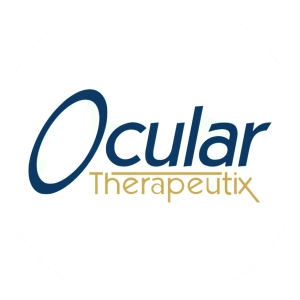[8-K] OCULAR THERAPEUTIX, INC Reports Material Event
UNITED STATES
SECURITIES AND EXCHANGE COMMISSION
WASHINGTON, D.C. 20549
FORM
CURRENT REPORT
Pursuant to Section 13 or 15(d)
of the Securities Exchange Act of 1934
Date of Report (Date of earliest event reported):
(Exact Name of Company as Specified in Charter)
| (State or Other Jurisdiction
of Incorporation) |
(Commission File Number) |
(IRS Employer Identification No.) |
(Address of Principal Executive Offices) (Zip Code)
Company’s telephone number, including area
code: (
Check the appropriate box below if the Form 8-K filing is intended to simultaneously satisfy the filing obligation of the registrant under any of the following provisions:
| Written communications pursuant to Rule 425 under the Securities Act (17 CFR 230.425) |
| Soliciting material pursuant to Rule 14a-12 under the Exchange Act (17 CFR 240.14a-12) |
| Pre-commencement communications pursuant to Rule 14d-2(b) under the Exchange Act (17 CFR 240.14d-2(b)) |
| Pre-commencement communications pursuant to Rule 13e-4(c) under the Exchange Act (17 CFR 240.13e-4(c)) |
Securities registered pursuant to Section 12(b) of the Act:
| Title of each class | Trading Symbol(s) | Name of
each exchange on which registered | ||
Indicate by check mark whether the registrant is an emerging growth company as defined in Rule 405 of the Securities Act of 1933 (§230.405 of this chapter) or Rule 12b-2 of the Securities Exchange Act of 1934 (§240.12b-2 of this chapter).
Emerging growth company
If an emerging growth company, indicate by check mark if the registrant has elected not to use the extended transition period for complying with any new or revised financial accounting standards provided pursuant to Section 13(a) of the Exchange Act. ¨
Item 8.01. Other Events.
On September 30, 2025, Ocular Therapeutix, Inc., or the Company, announced certain updates regarding its development programs for AXPAXLI (also known as OTX-TKI), the Company’s investigational, bioresorbable, intravitreal hydrogel incorporating axitinib, a small molecule, multi-target, tyrosine kinase inhibitor with anti-angiogenic properties. The Company is currently evaluating AXPAXLI for the treatment of wet age-related macular degeneration, or wet AMD, and plans to evaluate AXPAXLI for the treatment of non-proliferative diabetic retinopathy, or NPDR.
Update on wet AMD Program
SOL-1 Clinical Trial
The Company is currently conducting a repeat-dosing registrational Phase 3 clinical trial, which the Company refers to as the SOL-1 trial, to assess the safety and efficacy of AXPAXLI in subjects with wet AMD. The SOL-1 trial is designed as a prospective, multi-center, double-masked, randomized (1:1), parallel-group, two-arm superiority trial comparing a single injection of AXPAXLI 450 µg to a single injection of aflibercept 2 mg.
The SOL-1 trial completed the randomization of 344 subjects with a diagnosis of active macular choroidal neovascularization at screening in December 2024. Under the trial protocol, subjects were eligible for enrollment in the SOL-1 trial if they were treatment-naïve for wet AMD in the study eye; had central subfield thickness, or CSFT, of less than or equal to 500 microns; and had a Best Corrected Visual Acuity, or BCVA, of at least 54 letters as measured by the Early Treatment of Diabetic Retinopathy Study, or ETDRS, letters chart (approximately 20/80 Snellen equivalent vision). After screening, enrolled subjects received two aflibercept 2 mg loading doses at Weeks -8 and -4. Subjects reaching either a BCVA of greater than or equal to 84 ETDRS letters (approximately 20/20 Snellen equivalent vision) or experiencing an improvement of at least 10 ETDRS letters with a reduction in CSFT to no greater than 350 microns after these injections were randomized in the trial.
The primary endpoint of the SOL-1 trial is the proportion of subjects who maintain visual acuity, defined as a loss of fewer than 15 ETDRS letters from baseline, at Week 36. One of the secondary endpoints being evaluated is the proportion of subjects who maintain visual acuity measured at Week 52. At Weeks 52 and 76, all subjects that were randomized in the trial at Day 1, including subjects who previously received supplemental anti-VEGF treatment, are re-dosed with their respective initial treatment of a single injection of AXPAXLI 450 µg in the investigational arm or a single injection of aflibercept 2 mg in the control arm. Subjects will be followed for safety until the end of Year 2.
Retention in the trial continues to exceed greater than 95% of randomized subjects remaining on-trial to date, and rescues reviewed under masking suggest greater than 95% of rescue events to date have met pre-established protocol-defined criteria. To date, no new or unexpected safety signals have been observed for AXPAXLI in the SOL-1 trial, for which safety is monitored through an independent data safety monitoring committee.
The Company is conducting the SOL-1 trial in accordance with a special protocol assessment, or SPA, agreement with the U.S. Food and Drug Administration, or FDA. The Company continues to expect topline results for the SOL-1 trial to be available in the first quarter of 2026 after the completion of the Week 52 visits for all subjects in the trial.
SOL-R Clinical Trial
The Company is also conducting a repeat-dosing registrational Phase 3 clinical trial, which the Company refers to as the SOL-R trial, to evaluate the non-inferiority of AXPAXLI 450 µg dosed every 24 weeks for the treatment of wet AMD compared to aflibercept 2 mg dosed on-label every eight weeks. The SOL-R trial is designed as a multi-center, double-masked, randomized (2:2:1), three-arm trial and is expected to randomize approximately 555 subjects that are either treatment naïve or have been diagnosed with wet AMD in the study eye within about four months prior to enrollment. To qualify for screening in the SOL-R trial, subjects must have a BCVA of at least 34 ETDRS letters (approximately 20/200 Snellen equivalent vision).
Over the six months prior to randomization, enrolled subjects are given three screening doses of any anti-VEGF therapy, excluding brolucizumab-dbll, and monitored to exclude subjects demonstrating early persistent fluid or significant retinal fluid fluctuations. Subjects maintaining a CSFT of no greater than 350 microns at Weeks -12 and -8 and not experiencing a CSFT increase of greater than 35 microns from their lowest CSFT at any prior visit then receive two loading doses of aflibercept 2 mg at Weeks -8 and -4 prior to randomization.
Subjects in the first arm of the SOL-R trial receive a single dose of AXPAXLI at Day 1 and are re-dosed at Weeks 24, 48, and 72. Subjects in the second arm receive aflibercept 2 mg on-label every eight weeks. Subjects in the third arm receive a single dose of aflibercept 8 mg at Day 1 and are re-dosed at Weeks 24, 48, and 72.
The primary endpoint of SOL-R is to demonstrate non-inferiority in mean BCVA change from baseline between the AXPAXLI and on-label aflibercept 2 mg arms at Week 56. The third arm of the SOL-R trial, which has only been included for masking purposes, is not part of the non-inferiority analysis. Based on FDA guidance, the non-inferiority margin for the lower bound for the trial has been established at -4.5 letters of mean BCVA.
The Company has completed enrollment of the SOL-R trial and randomization is ongoing. The Company continues to expect topline results for the SOL-R trial to be available in the first half of 2027.
If the Company were to receive favorable results from both the SOL-1 and SOL-R trials, it plans to submit a new drug application to the FDA for marketing approval of AXPAXLI for the treatment of wet AMD following the receipt of topline data from SOL-R.
SOL-X Clinical Trial
The Company plans to initiate a long-term, multi-center, open-label extension clinical trial, which the Company refers to as the SOL-X trial, to evaluate subjects who have completed their two-year safety follow-up visits in either the SOL-1 or SOL-R trials for an additional three years. The primary objectives of the planned SOL-X trial are to evaluate the long-term safety of AXPAXLI; to explore long-term visual outcomes, including visual acuity and the incidence and/or progression of fibrosis and macular atrophy; and to evaluate the impact of delayed initiation of AXPAXLI in patients who initially were randomized to receive aflibercept in either SOL-1 or SOL-R. According to the planned trial design, subjects enrolled in the SOL-X trial are to receive AXPAXLI every 24 weeks and are to be evaluated at Week 4, Week 12, and every 12 weeks thereafter.
Update on Diabetic Retinopathy Program
The Company also announced its plans to initiate a Phase 3 clinical program for NPDR. Based on third-party market research data, the Company estimates that fewer than one percent (1%) of NPDR patients in the United States are currently treated with approved anti-vascular endothelial growth factor, or anti-VEGF, therapies.
HELIOS-2 Clinical Trial
The Company plans to initiate a Phase 3 clinical trial, which the Company refers to as the HELIOS-2 trial, to evaluate the safety and efficacy of AXPAXLI in approximately 432 subjects with moderately severe to severe NPDR without center-involved diabetic macular edema, or DME. The planned HELIOS-2 trial is designed to be a multi-center, double-masked, randomized (1:1), parallel-group, two-arm superiority trial comparing a single injection of AXPAXLI 450 µg to a single injection of ranibizumab 0.3 mg. The trial is expected to include subjects with non-center-involved DME.
According to the planned trial design, eligible subjects in the HELIOS-2 trial will be randomized to receive either a single dose of AXPAXLI or a single dose of ranibizumab. At Week 52, all subjects that were randomized in the trial will be re-dosed with their respective initial treatments. Subjects will be assessed monthly through Year 1 and every other month thereafter for safety through the end of Year 2. Subjects and designated trial personnel will remain masked through the end of Year 2.
The severity of diabetic retinopathy is commonly assessed using an objective severity score assessed based on graded retinal images, which is referred to as the diabetic retinopathy severity score, or DRSS. The primary endpoint of the HELIOS-2 clinical trial is subjects’ ordinal 2-step DRSS change status from baseline—comparing whether subjects have experienced at least a two-step improvement, at least a two-step worsening, or less than a two-step improvement or worsening—assessed at Week 52.
In August 2025, the Company received written agreement regarding the overall design of the HELIOS-2 clinical trial, including the proposed novel ordinal endpoint and statistical analysis plan, from the FDA under a SPA agreement.
HELIOS-3 Clinical Trial
The Company also plans to initiate a second Phase 3 clinical trial, which the Company refers to as the HELIOS-3 trial, to evaluate the safety and efficacy of AXPAXLI in approximately 930 subjects with moderately severe to severe NPDR without center-involved DME. The planned HELIOS-3 trial is designed to be a multi-center, double-masked, randomized (1:1:1), three-arm superiority trial comparing AXPAXLI to a sham comparator. Similar to the HELIOS-2 trial, the HELIOS-3 clinical trial is also expected to include subjects with non-center-involved DME.
According to the planned trial design, eligible subjects in the HELIOS-3 trial will be randomized as follows: subjects in the first arm will receive a single injection of AXPAXLI 450 µg at Day 1 and will be re-dosed with AXPAXLI at Week 24; subjects in the second arm will receive a single injection of AXPAXLI 450 µg at Day 1 and a sham injection at Week 24; and subjects in the third arm will receive sham injections at both Day 1 and Week 24. Subjects will be assessed every three months throughout the trial, and subjects and designated trial personnel will remain masked through the end of Week 52.
The primary endpoint of the HELIOS-3 clinical trial is identical to the primary endpoint of the HELIOS-2 trial, subjects’ ordinal 2-step DRSS change status from baseline as assessed at Week 52.
Update on Intellectual Property Portfolio in Connection with AXPAXLI
In September 2025, the Company received a notice of allowance from the U.S. Patent and Trademark Office in connection with a patent application submitted by the Company that recites claims covering methods of treating ocular diseases with AXPAXLI. The Company anticipates this notice of allowance to result in the issuance of a U.S. patent after administrative processes have been completed. Such patent would be expected to expire in 2044, absent any extensions.
Cautionary Note on Forward-Looking Statements
Any statements in this Current Report on Form 8-K about future expectations, plans, and prospects for the Company, including the development and regulatory status of the Company’s product candidates; the timing, design, enrollment, randomization, conduct and retention of subjects in the Company’s clinical trials, including the Company’s SOL-1 and SOL-R Phase 3 clinical trials of AXPAXLI (also known as OTX-TKI) for the treatment of wet AMD, the Company’s planned SOL-X clinical trial of AXPAXLI for the treatment of wet AMD, and the Company’s planned HELIOS-2 and HELIOS-3 clinical trials of AXPAXLI for the treatment of NPDR; the Company’s issuance of additional patent protection in connection with AXPAXLI; the Company’s plans to advance AXPAXLI, OTX-TIC, and its other product candidates; the potential utility or adoption, if approved, of any of the Company’s product candidates; the Company’s cash runway and the sufficiency of the Company’s cash resources; and other statements containing the words “anticipate”, “believe”, “estimate”, “expect”, “intend”, “designed”, “goal”, “may”, “might”, “plan”, “predict”, “project”, “target”, “potential”, “will”, “would”, “could”, “should”, “continue”, and similar expressions, constitute forward-looking statements within the meaning of The Private Securities Litigation Reform Act of 1995. Actual results may differ materially from those indicated by such forward-looking statements as a result of various important factors. Such forward-looking statements involve substantial risks and uncertainties that could cause the Company’s development programs, future results, performance, or achievements to differ significantly from those expressed or implied by the forward-looking statements. Such risks and uncertainties include, among others, the timing and costs involved in commercializing any product or product candidate that receives regulatory approval; the ability to retain regulatory approval of any product or product candidate that receives regulatory approval; the ability to maintain and the sufficiency of product, procedure and any other reimbursement codes for DEXTENZA; the initiation, design, timing, conduct and outcomes of ongoing and planned clinical trials, including the SOL-1 trial, the SOL-R trial, the planned SOL-X trial, the planned HELIOS-2 trial, and the planned HELIOS-3 trial; the risk that the FDA will not agree with the Company’s interpretation of the written agreements under the Special Protocol Assessments for AXPAXLI, including for the SOL-1 and HELIOS-2 trials; the risk that even though the FDA has agreed with the overall design of the SOL-1 and HELIOS-2 trials, the FDA may not find that the data generated by the applicable trial supports potential marketing approval; the risk that the FDA might not agree to the Company’s design, protocol, and statistical analysis plan of the SOL-R trial or the planned HELIOS-3 trial; the risk that the Company and the FDA may not agree on the registrational pathway for any of its product candidates; uncertainty as to whether the data from earlier clinical trials will be predictive of the data of later clinical trials, particularly later clinical trials that have a different design or utilize a different formulation than the earlier trials, whether preliminary or interim data from a clinical trial (including masked safety or masked rescue data from the Company’s SOL-1 trial or SOL-R trial) will be predictive of final data from such trial, or whether data from a clinical trial assessing a product candidate for one indication will be predictive of results in other indications; uncertainty as to whether data from the Company’s SOL-X trial will demonstrate clinically meaningful, long-term benefits; uncertainties regarding the potential commercial advantages and/or position of the Company’s product candidates; availability of data from clinical trials and expectations for regulatory submissions and approvals; the Company’s scientific approach and general development progress; uncertainties regarding whether allowed claims as specified in a notice of allowance will result in an issued patent; uncertainties inherent in estimating the Company’s cash runway, future expenses and other financial results, including its ability to fund future operations, including clinical trials; the Company’s existing indebtedness and the ability of the Company’s creditors to accelerate the maturity of such indebtedness upon the occurrence of certain events of default; and other factors discussed in the “Risk Factors” section contained in the Company’s quarterly and annual reports on file with the Securities and Exchange Commission. In addition, the forward-looking statements included in this Current Report on Form 8-K represent the Company’s views as of the date of this Current Report on Form 8-K. The Company anticipates that subsequent events and developments may cause the Company’s views to change. However, while the Company may elect to update these forward-looking statements at some point in the future, the Company specifically disclaims any obligation to do so, whether as a result of new information, future events or otherwise, except as required by law. These forward-looking statements should not be relied upon as representing the Company’s views as of any date subsequent to the date of this Current Report on Form 8-K.
SIGNATURES
Pursuant to the requirements of the Securities Exchange Act of 1934, the registrant has duly caused this report to be signed on its behalf by the undersigned hereunto duly authorized.
| OCULAR THERAPEUTIX, INC. | ||
| Date: September 30, 2025 | By: | /s/ Donald Notman |
| Donald Notman | ||
| Chief Financial Officer and Chief Operating Officer | ||





